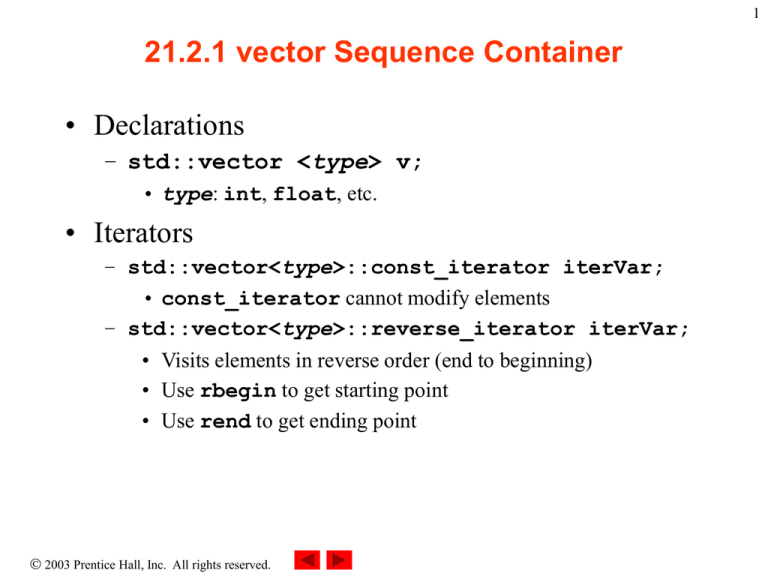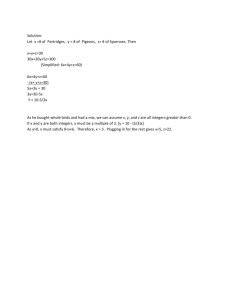
1
21.2.1 vector Sequence Container
• Declarations
– std::vector <type> v;
• type: int, float, etc.
• Iterators
– std::vector<type>::const_iterator iterVar;
• const_iterator cannot modify elements
– std::vector<type>::reverse_iterator iterVar;
• Visits elements in reverse order (end to beginning)
• Use rbegin to get starting point
• Use rend to get ending point
2003 Prentice Hall, Inc. All rights reserved.
2
21.2.1 vector Sequence Container
• vector functions
– v.push_back(value)
• Add element to end (found in all sequence containers).
– v.size()
• Current size of vector
– v.capacity()
• How much vector can hold before reallocating memory
• Reallocation doubles size
– vector<type> v(a, a + SIZE)
• Creates vector v with elements from array a up to (not including)
a + SIZE
2003 Prentice Hall, Inc. All rights reserved.
3
21.2.1 vector Sequence Container
• vector functions
– v.insert(iterator, value )
• Inserts value before location of iterator
– v.insert(iterator, array , array + SIZE)
• Inserts array elements (up to, but not including array + SIZE) into
vector
– v.erase( iterator )
• Remove element from container
– v.erase( iter1, iter2 )
• Remove elements starting from iter1 and up to (not including)
iter2
– v.clear()
• Erases entire container
2003 Prentice Hall, Inc. All rights reserved.
4
21.2.1 vector Sequence Container
• vector functions operations
– v.front(), v.back()
• Return first and last element
– v.[elementNumber] = value;
• Assign value to an element
– v.at[elementNumber] = value;
• As above, with range checking
• out_of_bounds exception
2003 Prentice Hall, Inc. All rights reserved.
5
21.2.1 vector Sequence Container
• ostream_iterator
– std::ostream_iterator< type >
Name( outputStream, separator );
• type: outputs values of a certain type
• outputStream: iterator output location
• separator: character separating outputs
• Example
– std::ostream_iterator< int > output( cout, " " );
– std::copy( iterator1, iterator2, output );
• Copies elements from iterator1 up to (not including)
iterator2 to output, an ostream_iterator
2003 Prentice Hall, Inc. All rights reserved.
1
2
3
4
5
6
7
8
9
10
11
12
13
14
15
16
17
18
19
20
21
22
23
24
25
26
// Fig. 21.14: fig21_14.cpp
// Demonstrating standard library vector class template.
#include <iostream>
Outline
fig21_14.cpp
(1 of 3)
using std::cout;
using std::cin;
using std::endl;
#include <vector>
6
// vector class-template definition
// prototype for function template printVector
template < class T >
void printVector( const std::vector< T > &integers2 );
int main()
{
Create a
const int SIZE = 6;
int array[ SIZE ] = { 1, 2, 3, 4, 5, 6 };
std::vector< int > integers;
cout <<
<<
<<
<<
vector of ints.
Call member functions.
"The initial size of integers is: "
integers.size()
"\nThe initial capacity of integers is: "
integers.capacity();
2003 Prentice Hall, Inc.
All rights reserved.
27
28
29
30
31
32
33
34
35
36
37
38
39
40
41
42
43
44
45
// function push_back
integers.push_back( 2
integers.push_back( 3
integers.push_back( 4
is in every sequence collection
);
);
);
7
Add elements to end of Outline
vector using push_back.
cout << "\nThe size of integers is: " << integers.size()
<< "\nThe capacity of integers is: "
<< integers.capacity();
fig21_14.cpp
(2 of 3)
cout << "\n\nOutput array using pointer notation: ";
for ( int *ptr = array; ptr != array + SIZE; ++ptr )
cout << *ptr << ' ';
cout << "\nOutput vector using iterator notation: ";
printVector( integers );
cout << "\nReversed contents of vector integers: ";
2003 Prentice Hall, Inc.
All rights reserved.
46
47
48
49
50
51
52
53
54
55
56
57
58
59
60
61
62
63
64
65
66
67
68
69
70
8
std::vector< int >::reverse_iterator reverseIterator;
for ( reverseIterator = integers.rbegin();
reverseIterator!= integers.rend();
++reverseIterator )
cout << *reverseIterator << ' ';
Outline
Walk through vector
fig21_14.cpp
backwards using (3
a of 3)
reverse_iterator.
cout << endl;
return 0;
} // end main
// function template for outputting vector elements
template < class T >
void printVector( const std::vector< T > &integers2 )
{
std::vector< T >::const_iterator constIterator;
Template function to walk
through vector forwards.
for ( constIterator = integers2.begin();
constIterator != integers2.end();
constIterator++ )
cout << *constIterator << ' ';
} // end function printVector
2003 Prentice Hall, Inc.
All rights reserved.
The
The
The
The
initial size of v is: 0
initial capacity of v is: 0
size of v is: 3
capacity of v is: 4
Contents of array a using pointer notation: 1 2 3 4 5 6
Contents of vector v using iterator notation: 2 3 4
Reversed contents of vector v: 4 3 2
9
Outline
fig21_14.cpp
output (1 of 1)
2003 Prentice Hall, Inc.
All rights reserved.
1
2
3
4
5
6
7
8
9
10
11
12
13
14
15
16
17
18
19
20
21
22
23
24
25
10
// Fig. 21.15: fig21_15.cpp
// Testing Standard Library vector class template
// element-manipulation functions.
#include <iostream>
Outline
fig21_15.cpp
(1 of 3)
using std::cout;
using std::endl;
#include <vector>
#include <algorithm>
// vector class-template definition
// copy algorithm
int main()
{
const int SIZE = 6;
int array[ SIZE ] = { 1, 2, 3, 4, 5, 6 };
std::vector< int > integers( array, array + SIZE );
std::ostream_iterator< int > output( cout, " " );
Create vector (initialized
using an array) and
ostream_iterator.
Copy range of iterators to output
(ostream_iterator).
cout << "Vector integers contains: ";
std::copy( integers.begin(), integers.end(), output );
cout << "\nFirst element of integers: " << integers.front()
<< "\nLast element of integers: " << integers.back();
2003 Prentice Hall, Inc.
All rights reserved.
26
27
28
29
30
31
32
33
34
35
36
37
38
39
40
41
42
43
44
45
46
47
48
49
50
51
integers[ 0 ] = 7;
integers.at( 2 ) = 10;
// set first element to 7
// set element at position 2 to 10
// insert 22 as 2nd element
integers.insert( integers.begin() + 1, 22 );
11
Outline
More vector member
fig21_15.cpp
functions.
(2 of 3)
cout << "\n\nContents of vector integers after changes: ";
std::copy( integers.begin(), integers.end(), output );
// access out-of-range element
try {
integers.at( 100 ) = 777;
at has range checking, and
can throw an exception.
} // end try
// catch out_of_range exception
catch ( std::out_of_range outOfRange ) {
cout << "\n\nException: " << outOfRange.what();
} // end catch
// erase first element
integers.erase( integers.begin() );
cout << "\n\nVector integers after erasing first element: ";
std::copy( integers.begin(), integers.end(), output );
2003 Prentice Hall, Inc.
All rights reserved.
52
53
54
55
56
57
58
59
60
61
62
63
64
65
66
67
68
69
70
71
// erase remaining elements
integers.erase( integers.begin(), integers.end() );
cout << "\nAfter erasing all elements, vector integers "
<< ( integers.empty() ? "is" : "is not" ) << " empty";
// insert elements from array
integers.insert( integers.begin(), array, array + SIZE );
cout << "\n\nContents of vector integers before clear: ";
std::copy( integers.begin(), integers.end(), output );
12
Outline
fig21_15.cpp
(3 of 3)
// empty integers; clear calls erase to empty a collection
integers.clear();
cout << "\nAfter clear, vector integers "
<< ( integers.empty() ? "is" : "is not" ) << " empty";
cout << endl;
return 0;
} // end main
2003 Prentice Hall, Inc.
All rights reserved.
Vector integers contains: 1 2 3 4 5 6
First element of integers: 1
Last element of integers: 6
Contents of vector integers after changes: 7 22 2 10 4 5 6
13
Outline
fig21_15.cpp
output (1 of 1)
Exception: invalid vector<T> subscript
Vector integers after erasing first element: 22 2 10 4 5 6
After erasing all elements, vector integers is empty
Contents of vector integers before clear: 1 2 3 4 5 6
After clear, vector integers is empty
2003 Prentice Hall, Inc.
All rights reserved.







